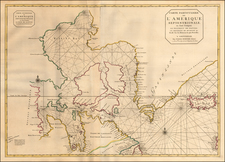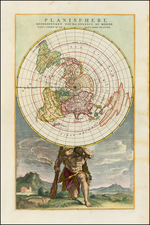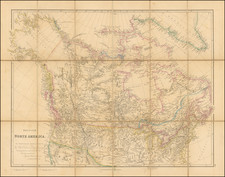Detailed map illustrating the probable route of Arctic explorer Sir John Franklin's ill-fated 1845 expedition, the disappearance of which was one of the most enduring mysteries in the history of exploration.
In 1845, Sir John Franklin left England on an expedition to the Canadian Arctic, in an attempt to navigate the Northwest Passage. Rear-Admiral Sir John Franklin (1786-1847) was an exceedingly experienced explorer and former colonial governor, and this marked his fourth voyage to the Northern Polar regions. As noted on the map, his vessels the Erebus and Terror (their tracks noted by a red line), with 128 men aboard, were last seen in the Davis Strait, between Greenland and Baffin Island an July 26, 1845.
From there, Franklin's ships vanished into the Arctic Archipelago. Urged by Franklin's wife, Lady Jane Franklin, in 1846, the Admiralty launched a search for Franklin's expedition, that was to become the largest operation of its kind of the 19th Century. These early efforts proved unsuccessful, however, in 1854, explorer John Rae found relics relating to Franklin's expedition on King William's Island. In light of these discoveries, the present map employs the blue lines in an effort to reconstruct the route by which Franklin's vessels could have drifted in sea ice southwards from their intended course, based on the observations and theories on the nature of Arctic currents compiled by Captain Irminger of the Danish Navy. The chart also shows the routes of the various search parties, from 1848 to 1855.
Further evidence of the expedition's fate was found on King William's Island in 1859, but it was not until 1981, when Professor Owen Beattie found the bodies of the lost sailors, and definitively pieced together the story behind the fate of the expedition.
The map appeared in the Journal of the Royal Geographical Society, to accompany the comments of Alexander G. Findlay on the probable course of Franklin's voyage.
The map is a fascinating artifact relating to the greatest search operation of the Victorian era, and one of the most captivating Arctic mysteries.










![[Glaciers & Polar Ice Packs, etc.] Arctic Ocean Greenland](https://storage.googleapis.com/raremaps/img/small/79033.jpg)


![[ Queen Anne's War - Failed Attack on French Canada -- Petition to Queen Anne from the Colony of New York seeking reimbursement for a failed conquest of New France during Queen Anne's War ] To the Queens most Excellent Majesty . . . 1709](https://storage.googleapis.com/raremaps/img/small/85409.jpg)
![[Whaling Operations] Pesca della Balena | Pesca del Pesce Sega](https://storage.googleapis.com/raremaps/img/small/78472.jpg)